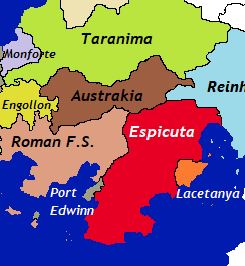Espicuta (Teremara)
Queendom of Espicuta Reino de Espicuta | |
|---|---|
|
Flag | |
Motto: "Dios salve a la Reina" God save the Queen | |
Anthem: Marcha Real | |
 Espicuta is located in southern Madurin, Teremara. | |
| Capital and largest city | Aquilla |
| Official languages | Espicutan |
| Recognised national languages | Lacetan dialect, Common Language |
| Demonym(s) | Espicutan |
| Government | Constitutional Parliamentary Monarchy |
• Monarch | Maria IV |
| Alejandro Alcade | |
| Duchess of Jedora | |
| Legislature | Parliament |
| Council of Nobles | |
| Consejo Popular | |
| Currency | Riyal (RIY) |
| Driving side | right |
| Internet TLD | .es |
The Queendom of Espicuta is a country in the region of Teremara, located on the southern side of the continent of Madurin. It borders the Madurin Sea to the south and east; with Lacetanya also on its eastern side, to the west by Port Edwinn and the Roman Free States, and to the north by Austrakia and Reinhalt. Espicuta also comprises several small overseas terriories, the last remnants of the Espicutan colonial empire which once covered significant areas of Teremara and beyond, these territories are mostly isolated islands.
In ancient times, Espciuta saw the birth of the Hispanic people in Teremara and came under the influence of Roma along with Lacetanya. Following the collapse of the Roman Free States in eastern Madurin, Espicuta absorbed Lacetanya and endured serveral civil wars until the period known as the Espicutan Golden Age began in the late 16th century and lasted until the early 18th century. During this period, Espicuta's population increased dramatically, as did its wealth and prestige. The country amassed a significant colonial empire, establishing colonies and protectorates across Teremara and beyond. Several colonies broke away from the Espicutan Empire in the early to mid 19th century, including San Rosito and Gran Ventana. More recently, Espciuta endured a bloody civil war in the early 20th century but has since stabilised and become a member of the TSO.
